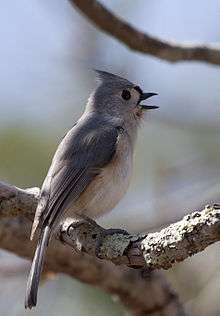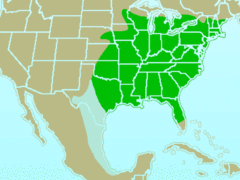Tufted titmouse
| Tufted titmouse | |
|---|---|
 | |
| Adult singing | |
| Scientific classification | |
| Kingdom: | Animalia |
| Phylum: | Chordata |
| Class: | Aves |
| Subclass: | Neornithes |
| Infraclass: | Neognathae |
| Superorder: | Neoaves |
| Order: | Passeriformes |
| Suborder: | Passeri |
| Infraorder: | Passerida |
| Family: | Paridae |
| Genus: | Baeolophus |
| Species: | B. bicolor |
| Binomial name | |
| Baeolophus bicolor (Linnaeus, 1766) | |
 | |
| Combined range of tufted titmouse and black-crested titmouse | |
The tufted titmouse (Baeolophus bicolor) is a small songbird from North America, a species in the tit and chickadee family (Paridae). The black-crested titmouse, found from central and southern Texas southwards, was included as a subspecies but is now considered a separate species B. atricristatus.
These birds have grey upperparts and white underparts with a white face, a grey crest, a dark forehead and a short stout bill; they have rufous-coloured flanks. The song is usually described as a whistled peter-peter-peter. They make a variety of different sounds, most having a similar tone quality.
The habitat is deciduous and mixed woods as well as gardens, parks and shrubland[2] in the eastern United States; they barely range into southeastern Canada in the Great Lakes region. They are all-year residents in the area effectively circumscribed by the Great Plains, the Great Lakes, the Gulf of Mexico and the Atlantic Ocean. The range is expanding northwards, possibly due to increased availability of winter food at bird feeders. The birds are nowadays resident all year even in rural Ohio where there are few bird feeders, while it was noted around 1905 that many birds from these areas migrated south in winter.[2][3]
They forage actively on branches, sometimes on the ground, mainly eating insects, especially caterpillars, but also seeds, nuts and berries. They will store food for later use. They tend to be curious about their human neighbors and can sometimes be spotted on window ledges peering into the windows to watch what's going on inside. They are more shy when seen at bird feeders; their normal pattern there is to scout the feeder from the cover of trees or bushes, fly to the feeder, take a seed, and fly back to cover to eat it.
Tufted titmice nest in a hole in a tree, either a natural cavity, a man-made nest box, or sometimes an old woodpecker nest. They line the nest with soft materials, sometimes plucking hair from a live animal such as a dog.[4] If they find shed snake skin, they will try to incorporate pieces of it in their nest.[5] Their eggs are under an inch long and are white or cream-colored with brownish or purplish spots. Sometimes, a bird born the year before remains to help its parents raise the next year's young. The pair may remain together and defend their territory year-round. These birds are permanent residents and often join small mixed flocks in winter.
See also
References
- ↑ BirdLife International (2012). "Baeolophus bicolor". IUCN Red List of Threatened Species. Version 2013.2. International Union for Conservation of Nature. Retrieved 26 November 2013.
- 1 2 Ohio Ornithological Society (2004): Annotated Ohio state checklist
- ↑ Henninger, W. F. (1906). "A preliminary list of the birds of Seneca County, Ohio" (PDF). Wilson Bull. 18 (2): 47–60.
- ↑ "Tufted Titmouse, Audubon Field Guide". Retrieved 2015-08-17.
- ↑ Medlin, Elizabeth C.; Risch, Thomas S. (2006). "An Experimental Test of Snake Skin Use to Deter Nest Predation". Condor. 108 (4): 963–965. doi:10.1650/0010-5422(2006)108[963:AETOSS]2.0.CO;2. Summary at conservationevidence.com
External links
| Wikimedia Commons has media related to Tufted titmouse. |
| Wikispecies has information related to: Baeolophus bicolor |
- "Tufted titmouse media". Internet Bird Collection.
- Tufted titmouse species account – Cornell Lab of Ornithology
- Tufted titmouse – Baeolophus bicolor – USGS Patuxent Bird Identification InfoCenter
- A couple of images at thomasoneil.com
- Tufted titmouse photo gallery at VIREO (Drexel University)
